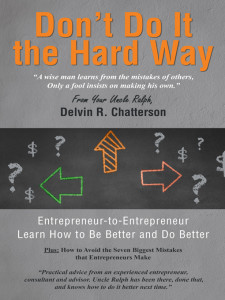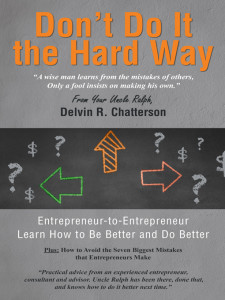Delvin R. Chatterson's Blog, page 13
April 26, 2016
“You got to trust somebody.”
This Real Life Story is loosely based on the real life experiences of your Uncle Ralph which he shares with other entrepreneurs in his book , “Don’t Do It the Hard Way.” Read the book.
Real Life Story: “You got to trust somebody.”
Business is built on trust.
 You have no choice. You have to assume that you can trust the people you are working with. You can never be sure that 100% are trustworthy, of course, but it’s best to follow the advice of Earnest Hemingway, “The only way to find out if you can trust someone is to trust them.”
You have no choice. You have to assume that you can trust the people you are working with. You can never be sure that 100% are trustworthy, of course, but it’s best to follow the advice of Earnest Hemingway, “The only way to find out if you can trust someone is to trust them.”
Maybe take limited risks until you are satisfied, but learn quickly who is not trustworthy and then avoid them like a fatal disease. “Once burnt, twice shy.”
Developing trust is the final step in building a sustainable long-term business relationship that will be valuable to both parties. It starts with awareness and knowledge, then progresses to liking someone and continues to respect and confidence and finally trust. Remember to build your relationships along that progression and give no one cause to doubt your trustworthiness.
It must be terrible to be so paranoid that you constantly watch, worry, and attempt to police and control everybody around you, because you trust nobody. Maybe you were raised to think that way.
There is that familiar old story of the shopkeeper who took his eldest son into the store one day and said, “Son, today is the day I teach you the most important lesson in business.” So he took his son to the store and said, “Now climb to the top of that ladder in the stock room, then jump down into my arms.”
“But Daddy, will you catch me?”
“Of course I’ll catch you. I’m your father. Trust me.”
So the boy jumped and his father stepped back to let him crash to the floor and said, “That’s the most important lesson in business. Don’t trust nobody!”
Recent surveys of trust among different generations demonstrate that we are at an all-time low in levels of trust. Millennials expect only 20% of the people around them are trustworthy, while most other generations are closer to 30%. Still a discouraging statistic. Driven by non-stop news of new scams, hackers, corporate fraud and universal sharing of every event that shakes our trust in our fellow human beings.
But that’s no way to live or to do business.
To badly paraphrase Bob Dylan, “You got to trust somebody.”
Your Uncle Ralph, Del Chatterson
Read more at: Learning Entrepreneurship Blogs .
Enlightened Entrepreneurship – Part 3: The Action Plan
Forget Forecasts
The Seven Biggest Mistakes and How to Avoid Them
Find the Exit before it’s an Emergency
When to Launch Your Business
The Four P’s of Salesmanship: “You wanna buy a book?”
Join our mailing list for more ideas, information and inspiration for entrepreneurs.
Click Here to check out Uncle Ralph’s books, “Don’t Do It the Hard Way” and “The Complete Do-It-Yourself Guide to Business Plans” Both are available online or at your favourite bookstore in hard cover, paperback or e-book.
The post “You got to trust somebody.” appeared first on Learning Entrepreneurship.
Of course you need a Business Plan
 Your Business Plan is an essential management tool that is too easily under-estimated as a useless bureaucratic requirement to apply for financing. “It would be easier if they just said No!”
Your Business Plan is an essential management tool that is too easily under-estimated as a useless bureaucratic requirement to apply for financing. “It would be easier if they just said No!”
My own experience with business plans has led me to the conclusion that became the sub-title of my book, The Complete Do-It-Yourself Guide to Business Plans:
“ It’s about the process, not the product .”
Do not make the mistake of focusing on filling in the blanks to create a Business Plan document. The real value for entrepreneurs in preparing a Business Plan is the process of involving your management team in the assessment of the market, study of competition, developing a business strategy and testing the financial consequences of different scenarios and alternative plans.
My first Business Plan was 30-years ago, when I started TTX Computer Products (a simple one page summary and first year budget), followed by a more formal Business Plan when we applied for a line of credit. It helped us get the first $50,000 and the process eventually got us up to loans of $4,800,000. My experience continued with other ventures and dozens of projects for clients in a wide variety of businesses. From start-ups through business expansion plans to successful exit strategies.
The most important lesson?
The value to an entrepreneur or business owner comes from the process, not the document.
Use the business planning process to understand the market, develop a strategic plan and test alternative scenarios. Then continuously review and revise the plan based on ongoing market feedback and actual results.
It’s a continuous process: Like any other road map, it should be consulted regularly. Do we still have the same destination? Are we on the right course? In the best vehicle? With the driver and passengers all in the right positions doing the right things?
What are the essential elements?
The objective is to prepare a document that describes the business opportunity, then defines the strategy, concept and business model to realize that opportunity and the operating plans to succeed as a sustainable long-term business.
The important steps in the process:
Analyse and understand the market, the opportunity and the competitive landscape.
Develop a strategy and action plan to realize the business opportunity.
Test alternative scenarios, strategies, operating plans and the potential financial results.
Document your final decisions on strategy and operating plans and the expected financial results.
The final Business Plan will have three parts – a description of the plan, the financial projections, and the supporting documents.
Who needs one and when?
A solid Business Plan is not just for start-ups seeking financing. It’s also for existing businesses to launch a new project, a new product, or enter new markets. Every business should have a documented strategic plan with measurable objectives that can be shared with management and employees, business partners and sources of financing. The documented Business Plan is also an important tool for preparing an exit strategy or management transition plan for businesses that are at that stage in their life cycle.
What are the biggest mistakes made in Business Plans?
Entrepreneurs often put too much focus on filling in the blanks of a template without providing solid data and analysis to validate the strategy and the financial forecasts. The plan may be missing the persuasive arguments on how you will succeed based on competitive advantages and your unique knowledge, skills, experience, contacts and resources. Do not neglect the sincere language that will attract believers to your stated mission, vision and values. Prepare to answer the tough questions, especially recognizing and responding to the risks and uncertainties.
The most important recommendations in The Complete Do-It-Yourself Guide to Business Plans?
First, you do not have to “Do-It-Yourself,” but you should know what will make it successful, so that you can provide direction to whoever is helping you prepare a Business Plan. Be prepared to defend the strategy and the numbers in your plan. Remember the objective is to prepare a plan that will generate confidence and enthusiasm in yourself and in others and that will serve as a guide to managing and monitoring performance for a successful long-term sustainable business.
Happy planning!
Your Uncle Ralph, Del Chatterson
Read more Learning Entrepreneurship Blogs .
Enlightened Entrepreneurship – Part 3: The Action Plan
Forget Forecasts
The Seven Biggest Mistakes and How to Avoid Them
Find the Exit before it’s an Emergency
The Four P’s of Salesmanship: “You wanna buy a book?”
Join our mailing list for more ideas, information and inspiration for entrepreneurs.
Click Here to check out Uncle Ralph’s books, “Don’t Do It the Hard Way” and “The Complete Do-It-Yourself Guide to Business Plans” Both are available online or at your favourite bookstore in hard cover, paperback or e-book.
The post Of course you need a Business Plan appeared first on Learning Entrepreneurship.
April 20, 2016
Keep your Balance
Responding to Challenge #1:
Strategic Leadership & Management Effectiveness
Keep your Balance
 It is easy for owner-managers to get pre-occupied by the daily demands for attention – chasing opportunities, resolving customer complaints, managing employee performance, satisfying business partners, governments and the bank. Stepping back to look at the big picture and assessing performance against the original strategic plan is easily neglected.
It is easy for owner-managers to get pre-occupied by the daily demands for attention – chasing opportunities, resolving customer complaints, managing employee performance, satisfying business partners, governments and the bank. Stepping back to look at the big picture and assessing performance against the original strategic plan is easily neglected.
That remains the entrepreneur’s No.1 Challenge: balancing the need for strategic leadership with the demands for operational effectiveness.
Too busy fighting fires to work on fire prevention?
To succeed in building a long-term sustainable business, it is essential that owner-managers find the appropriate balance in applying time, effort and resources to both strategic leadership and operations management.
Two issues, three steps to success
My approach to managing that balance is to apply the same three steps to each issue.
Strategic Leadership
1. Assess performance
Continuously assess market conditions, customer feedback and the competitive landscape. Check that your intended strategic positioning, branding and corporate culture are in line with current customer and employee perceptions. Confirm that you are correctly matching your strategic and competitive advantage to market opportunities
2. Revise the plan
Review and revise, if necessary, your strategy, concept and business model. Update your Business Plan and marketing communications strategy.
3. Make improvements
Launch the new plan internally and provide strategic direction and support to the management team. Prepare new marketing communications and sales tools and take them to market.
Management Effectiveness
1. Assess performance
Regularly assess operating and financial performance by monitoring key indicators against your plan, industry averages and the best performers in your business.Survey employees and customers for satisfaction levels and feedback on areas for improvement. Maintain current and effective employee performance reviews for management and staff.
2. Revise the plan
Identify deficiencies and set new objectives for performance improvements. Update the Business Plan and internal performance objectives for management and staff.
3. Make improvements
Define and develop improvement projects and provide necessary management support and resources to achieve the objectives.
A simple process, but not easy. Achieving balance in managing business strategy and effective operations is still a challenge.
But worth continuous attention.
Your Uncle Ralph, Del Chatterson
Read more Learning Entrepreneurship Blogs .
Enlightened Entrepreneurship – Part 3: The Action Plan
Forget Forecasts
The Seven Biggest Mistakes and How to Avoid Them
Find the Exit before it’s an Emergency
The Four P’s of Salesmanship: “You wanna buy a book?”
Join our mailing list for more ideas, information and inspiration for entrepreneurs.
Click Here to check out Uncle Ralph’s books, “Don’t Do It the Hard Way” and “The Complete Do-It-Yourself Guide to Business Plans” Both are available online or at your favourite bookstore in hard cover, paperback or e-book.
The post Keep your Balance appeared first on Learning Entrepreneurship.
April 13, 2016
Entrepreneurial excellence: Challenge #1
 This article is from Chapter 4 of
Uncle Ralph’s, “Don’t Do It the Hard Way”.
Read the book.
This article is from Chapter 4 of
Uncle Ralph’s, “Don’t Do It the Hard Way”.
Read the book.
Challenge #1: Strategic Leadership + Management Effectiveness
Start with a plan.
As we started our e2eForum on a bright sunny spring morning, this was on the flipchart:
The Entrepreneur’s Challenge:
Strategic Leadership + Management Effectiveness
It is my favourite theme and I had been asked to decide on today’s discussion topic, so there it was. Some around the table had heard me rant on this subject before, so I was trying to approach it a little differently.
“Today I’m going to start by admitting to you my own biggest mistake as an entrepreneur – failing to continually think strategically. I was too often pre-occupied with operating issues and short-term problem solving. Stuck in the old dilemma of too busy fighting fires to ever work on fire prevention.”
“This was especially true in my first business, computer products distribution. There was so much detail to keep on top of – markets and technologies, customer service issues, managing employees and learning everything I had to know as a new entrepreneur about the running a business – from accounting systems and freight rates to lines of credit and payroll deductions.”
“I had all the usual excuses for being drawn into the daily crises and never getting back to the drawing board to review the original strategic plan and see if we were still on track. To be honest, our original plan was not very strategic and never looked past the first two or three years. It was only focused on making our numbers, not on strategic positioning and managing our important business relationships. We made good short-term decisions to maintain profitability and win our share of competitive battles, but did not effectively protect ourselves from conflicts with our major suppliers and were not prepared for the rapid decline in profit margins as competitors flooded the market.”
“We started business in the mid ‘80’s when IBM personal computers and the clones and compatibles were first landing on desktops everywhere – in offices, schools and homes. With our one primary product, computer monitors, we were initially competing with only about six major brand names and four other regional distributors.”
“Our customers were primarily the local computer stores that were on every second street corner and in every shopping centre. We were selling a few hundred monitors a month and average profit margins were at 12% to 14%; pretty healthy we thought. But high profits and fast growth brought a lot of competitors into the market. By the mid ‘90’s we had over forty competing brand names and at least twenty competing distributors. Profit margins in distribution slid to about 4%; no longer healthy. Our volume was up to ten times over our second or third year, but net profit was the same and we now had huge risks in inventory and receivables.”
“That’s when I made the decision to enter into the merger which would have helped us to diversify our product mix and customer portfolio and reduce the risks. Unfortunately, the merger didn’t work so we wound it down and I subsequently left the computer hardware industry about two years later. Very quickly after that consolidation eliminated most of the players in the personal computer market – only a few major brand names, three large multinational distributors and three or four national retail chains remained by the year 2000.”
“Any survivors from that era had to be very good at re-positioning their businesses to keep up with the rapid evolution of the computer business.”
“Your own business may not see rapid change like the computer industry, but I’m sure that whatever business you are in, technology and the Internet continuously affect how you do business. You have to adapt to keep up with changing competition and new customer expectations.”
“Don’t make the mistake I did of getting lost in the operating details and neglecting to raise the periscope and scan the horizon for oncoming threats or opportunities. Be prepared to respond.”
Keep your head up
“I do try to keep aware of what’s on the horizon,” said Dave, “but sometimes I have very limited choices available for my response. We expect our manufacturers to keep up with the technology and the competition and our bike dealers to do a good job of attracting customers and making the sale. As the national distributor, we provide the pipeline to market, but we need the people at both ends to work with us.”
“And it is true,” he added, “even if we’re in ‘old economy’ traditional businesses, we all have to keep up with technology – both to remain competitive and to rise to new customer expectations. The devices and applications all keep getting cheaper, easier to use and more effective at delivering the results. We simply cannot afford to stand still – the competition will beat us and the customers will leave us if we don’t keep sharpening our tools.”
Looking around the table it seemed we all agreed with Dave. Strategic vision and leadership need to be constantly applied to daily decision making.
Lack of strategic direction, in my opinion, may be the biggest mistake for entrepreneurs and can be fatal to the business.
Your Uncle Ralph, Del Chatterson
Read more Learning Entrepreneurship Blogs .
Enlightened Entrepreneurship – Part 3: The Action Plan
Forget Forecasts
The Seven Biggest Mistakes and How to Avoid Them
Find the Exit before it’s an Emergency
The Four P’s of Salesmanship: “You wanna buy a book?”
Join our mailing list for more ideas, information and inspiration for entrepreneurs.
Click Here to check out Uncle Ralph’s books, “Don’t Do It the Hard Way” and “The Complete Do-It-Yourself Guide to Business Plans” Both are available online or at your favourite bookstore in hard cover, paperback or e-book.
The post Entrepreneurial excellence: Challenge #1 appeared first on Learning Entrepreneurship.
April 12, 2016
Strategic error by Spieth at the Masters
Jordan Spieth’s strategic error cost him a win
 After an excellent first nine holes, he decided he could play safe with a six stroke lead. That’s when the wheels started to wobble and then fell off at the 12th. In three holes he lost six strokes, while Danny Willett continued the best round of the day with two more birdies. Suddenly Spieth was behind. In spite of regaining control for birdies himself on the 13th and 15th, he finished tied for second. After winning last year and holding the lead for seven consecutive rounds, he lost the chance to make history by joining only Jack Nicklaus, Nick Faldo and Tiger Woods in winning two consecutive Masters Championships.
After an excellent first nine holes, he decided he could play safe with a six stroke lead. That’s when the wheels started to wobble and then fell off at the 12th. In three holes he lost six strokes, while Danny Willett continued the best round of the day with two more birdies. Suddenly Spieth was behind. In spite of regaining control for birdies himself on the 13th and 15th, he finished tied for second. After winning last year and holding the lead for seven consecutive rounds, he lost the chance to make history by joining only Jack Nicklaus, Nick Faldo and Tiger Woods in winning two consecutive Masters Championships.
In commenting on his shocking fall from the lead, Spieth admitted that he had adjusted his strategy to playing cautiously for par, instead of continuing to strive for birdies. “I took just a little off my swing and the ball started to float right. On the 12th I just compounded the error.”
The lesson for entrepreneurs
So the lesson appears to be to stay with your winning strategy, until it doesn’t work anymore.
Do not adopt a new strategy until a correction is clearly required. Avoid continuously assessing and adjusting your strategy, focus instead on execution and the results. Monitor feedback and adjust only the tactics, techniques and processes to achieve the desired performance.
You will never win every round, but you will win more often if you stick to the plan and execute well. And you will continue to get better at the game.
Your Uncle Ralph, Del Chatterson
Read more articles like this one at : Business is Like Golf Blog
Friendly Competition Inspires Everybody
Stories behind the headlines
Match play: Beating one competitor at a time
Visit LearningEntrerpreneurship.com and join our mailing list for more ideas, information and inspiration for entrepreneurs.
Check out Uncle Ralph’s books, “Don’t Do It the Hard Way” and “The Complete Do-It-Yourself Guide to Business Plans” Available online or at your favourite bookstore in hard cover, paperback or e-book.
The post Strategic error by Spieth at the Masters appeared first on Learning Entrepreneurship.
April 7, 2016
That was easy, let’s do it again!
This article is from Chapter 5 of Uncle Ralph’s, “Don’t Do It the Hard Way”. Read the book.
That was easy, let’s do it again!
 We all tried hard to arrive early for the e2eForum meetings because it gave us time to chat informally with the other members and exchange comments on our businesses and other issues that were not on the day’s agenda.
We all tried hard to arrive early for the e2eForum meetings because it gave us time to chat informally with the other members and exchange comments on our businesses and other issues that were not on the day’s agenda.
Unfortunately, an accident on the expressway this morning had kept me from arriving early enough to review the agenda with Stan, who was chairing the meeting this week.
The discussion had already started and this was on the flipchart.
Discussion points: Serial Entrepreneurship
Another Start-up?
Or the next Screw- up?
What I heard was Paul was talking about the gourmet hamburger franchise he was considering investing in, “It looks like a safe investment and my son has some experience in the restaurant business. I’ve got the initial $60,000 and bank financing is easy because they love franchises.”
“Sorry, Paul,” said Dave, “but experience flipping burgers doesn’t mean your son knows how to run a burger joint. Even if the franchisor delivers all the management tools and support, do you really want to manage minimum wage staff and deal with unhappy customers complaining that your burgers suck? Your experience is all about managing highly qualified machinists and selling precision parts to multinational manufacturing businesses.”
“Yes, but I built a successful business in that industry, and this should be much easier. I have the time and the money and I need a new challenge to keep me interested. I don’t want to spend every day in retirement watching my money ride the stock market roller coaster.”
“It sounds like your entrepreneurial juices are percolating, Paul,” I said, “Maybe you should go back to the start-up criteria we talked about a few months ago. Look for an opportunity that really leverages your unique skills, knowledge, experience and contacts. Isn’t that what worked for you the first time?”
“True enough. All I bring to this business is a long history of eating hamburgers!” Paul was laughing at himself and it looked like he would leave his money in the bank, for now.
I was remembering what I have said to other successful businessmen: Making money doesn’t make you smart.What I said out loud was, “Before you throw your energy and money into a new venture, ask yourself a few important questions.”
“I hear another checklist coming!” chirped Larry.
“Thanks Larry, now I’ll have to give it a name. Let’s call it the Encore Performance Checklist. If you are determined to boast that you are a serial entrepreneur, not just a successful entrepreneur; then ask yourself these questions before you get started on your next venture:
What was it that made you succeed in your first business?
Did you build your business on your unique management ability, a new product idea, a preferred customer or supplier relationship? Which of these will apply to the new business?
What mistakes have you avoided in the past? Are you about to make them now? What new risks are you encountering for the first time?
Is now a good time to start something new? Are there no challenges left in your current business?
How much will a new initiative impact your current business and the demands on your time and resources?
Is your past success really transferable to the new business?”
“Many successful entrepreneurs have made the mistake of jumping into a new venture – merger, acquisition, restaurant franchise or real estate investment – and blown away the equity value they built in their original business. It’s another costly mistake to avoid.”
Brian shared his conclusion with us, “I’m now convinced that the next venture is something to set aside until I’m at the exit stage like Paul. When my current business is running itself and I have the time and money to very carefully select the next opportunity. I just don’t want to wait until I’m that old, sorry Paul. I’m thinking I’ll be ready for the next one at age 35.”
Stan added, “Too late for me, I’m already 39, but I’d like to accelerate the plan to get to that stage soon too. Then I can start the next one before I get bored and screw up the one I’ve got.”
I said, “I have seen that happen. Entrepreneurs who started to dabble in something more exciting, thinking their business was on cruise control and it headed into a crash landing instead.”
“So let’s avoid the unhappy ending of exit by default. Put it on the agenda for a future meeting – Preparing for Exit.”
We all agreed that was a good topic for a future meeting and concluded the e2eForum with our regular Roundtable update from each of the members before heading out for the day.
Your Uncle Ralph, Del Chatterson
Read more Learning Entrepreneurship Blogs .
Enlightened Entrepreneurship – Part 3: The Action Plan
Forget Forecasts
The Seven Biggest Mistakes and How to Avoid Them
Find the Exit before it’s an Emergency
When to Launch Your Business
The Four P’s of Salesmanship: “You wanna buy a book?”
Join our mailing list for more ideas, information and inspiration for entrepreneurs.
Click Here to check out Uncle Ralph’s books, “Don’t Do It the Hard Way” and “The Complete Do-It-Yourself Guide to Business Plans” Both are available online or at your favourite bookstore in hard cover, paperback or e-book.
The post That was easy, let’s do it again! appeared first on Learning Entrepreneurship.
April 6, 2016
Things not to say out loud
 This
Real Life Story
is an extract from
Uncle Ralph’s, “The Complete Do-It-Yourself Guide to Business Plans”.
Read the book.
This
Real Life Story
is an extract from
Uncle Ralph’s, “The Complete Do-It-Yourself Guide to Business Plans”.
Read the book.
Real Life Story: “Things not to say out loud.”
When you are finally sitting down at the bank and reviewing your impressive and irresistible business plan, please be careful what you say. These people are not your new best friends, regardless of how friendly and helpful they all seem.
Remember: Their interest is to avoid any risk of losing their funds and to make money on you. And avoiding risk is more important than chasing a new account.
Your objective is to build their confidence in the plan and your ability to deliver. In my experience, some clients will blurt out admissions that do not help their cause with bankers, investors or potential strategic partners.
Some real life examples:
“We don’t have any more money to put into the business, our mortgage and personal loans are already at the maximum.”
“I don’t really want to do this, but I lost my job and had a nervous breakdown. So it’s hard to find anything else.”
“The prototype is not yet working, but I’m sure we’ll get our first order soon.”
“This is obviously a multi-billion dollar market, so we only need 0.002 percent market share to meet our sales projections. And the product sells itself.”
“I don’t know where those numbers came from.”
Please try to be more discrete when you’re forced to admit some of the negatives in your plan. (However, if any of those admissions apply to you, then you are NOT ready to launch a business or request financing. Come up with better answers first.)
Honesty and full disclosure are good, but a confession of all your flaws is not required.
Whoever is listening to your pitch already knows that it is mostly fiction, that it will never go according to plan, and that they have a responsibility to protect their interests by asking the right questions and negotiating a good deal.
You should be equally professional about presenting your plan and defending your interests.
(Note: In all these Real life Stories, the actual names and business details have not been disclosed.)
Your Uncle Ralph, Del Chatterson
Read more at: Learning Entrepreneurship Blogs .
Enlightened Entrepreneurship – Part 3: The Action Plan
Forget Forecasts
The Seven Biggest Mistakes and How to Avoid Them
Find the Exit before it’s an Emergency
When to Launch Your Business
The Four P’s of Salesmanship: “You wanna buy a book?”
Join our mailing list for more ideas, information and inspiration for entrepreneurs.
Click Here to check out Uncle Ralph’s books, “Don’t Do It the Hard Way” and “The Complete Do-It-Yourself Guide to Business Plans” Both are available online or at your favourite bookstore in hard cover, paperback or e-book.
The post Things not to say out loud appeared first on Learning Entrepreneurship.
March 29, 2016
Time for a Business Tune-up?
SNAP: Strategic Needs Assessment and Performance Review
 A comprehensive business diagnostic will assess your strategic position, your plans and objectives and analyze your current performance to identify opportunities for improvement.
A comprehensive business diagnostic will assess your strategic position, your plans and objectives and analyze your current performance to identify opportunities for improvement.
It includes a review of the issues with management, employees and customers and an analysis of financial results, s9Don’t Do It the Hard Wayales and marketing performance, customer service and operating effectiveness. It will lead to a new plan that is more in line with your strategic objectives and delivers higher profitability and performance.
Our recommended approach
Start with a survey of the competitive landscape and your position in it. How do you fit in to meet customer needs? Do customers see you as a Porsche or a pick-up truck? Are your marketing campaigns and sales pitches all aligned with your strategic plan, on message, and directed at the right prospects with targeted opportunities?
Internally, the business diagnostic should include a survey of management and staff perceptions. Are you fun and friendly or severe and stressful? Do they see you supporting personal development and encouraging initiative in pursuit of business objectives?
Financial performance should be measured not only against your plans and forecasts, but also against industry average ratios and the performance of the best in your business. Look at your operating margins, leverage ratios, inventory and receivables turnover, sales performance in dollars per square foot or per sales rep or per dollar invested in plant and equipment. How do you compare?
When the business diagnostic is complete, share the results with your management team and develop a realistic plan to improve on the key performance measures and accelerate progress toward your strategic objectives.
It starts with a comprehensive and objective diagnostic and ends with a new plan.
Consider a Quick SNAP Review from DirectTech Solutions
Fixed Fee Diagnostic – only $1795
Includes:
Initial review of company background, sales and marketing performance and financial results.
Discussion with management of the strategic plan and objectives and current key issues.
Survey of up to three key staff members and three key employees.
Presentation of our analysis and recommendations
Visit DirectTech Solutions to learn more.
Limited offer to qualified clients. Standard consulting agreement applicable.
Please contact us to discuss your needs and how we may be able to assist you in doing better for your business.
Your Uncle Ralph, Del Chatterson
And check out two new books by Uncle Ralph, “Don’t Do It the Hard Way” and “The Complete Do-It-Yourself Guide to Business Plans.” available online or at your favourite bookstore. To learn more or buy a copy: Click here
Complete Do-It-Yourself Guide to Business Plans.” available online or at your favourite bookstore. To learn more or buy a copy: Click here
The post Time for a Business Tune-up? appeared first on Learning Entrepreneurship.
March 24, 2016
Match play: Beating one competitor at a time
Strategies for Match Play
 Most golf tournaments are stroke play, which means each golfer is trying to win with the lowest number of strokes over four rounds of 18 holes. In match play, each golfer it’s trying to win one hole at a time against one competitor at a time. You still have to play well, but the strategy is very different.
Most golf tournaments are stroke play, which means each golfer is trying to win with the lowest number of strokes over four rounds of 18 holes. In match play, each golfer it’s trying to win one hole at a time against one competitor at a time. You still have to play well, but the strategy is very different.
In stroke play, every stroke counts against the total over four days. You are effectively competing against the whole field of golfers over four days. In match play, you win or lose one hole at a time, so a bad hole and those extra strokes only count once. If your competitor is even worse on that hole, you can still win it. At the end of the day, the winner is the golfer who wins the most holes against his opponent on the round. Deciding on the cautious or low risk shot versus the aggressive or challenging shot, depends on how your opponent is doing on that hole and on the round against you. It’s a one-on-one competition, not the usual game of every golfer against the golf course.
Lessons for entrepreneurs:
In business, you also have to play your best game every day to win against the market. But sometimes, it’s you against one competitor in particular to win one specific customer. Adapt your strategy and game accordingly.
Play your strength against the competitor’s weakness. Focus on the customer’s currently perceived deficiencies in product performance, price or service. Provide a clear response to those deficiencies with your solutions that will fit the specific customer’s needs.
You may not win every round. But you can win; one competitor at a time, one customer at a time.
And you will continue to get better at the game,
Your Uncle Ralph, Del Chatterson
Read more articles like this one at: Business is Like Golf Blog 
Visit LearningEntrerpreneurship.com and join our mailing list for more ideas, information and inspiration for entrepreneurs.
Check out Uncle Ralph’s books, “Don’t Do It the Hard Way” and “The Complete Do-It-Yourself Guide to Business Plans” Available online or at your favourite bookstore in hard cover, paperback or e-book.
The post Match play: Beating one competitor at a time appeared first on Learning Entrepreneurship.
March 22, 2016
Evolution of Do-It-Yourself Marketing
It struck me recently in a meeting with two young entrepreneurs that we were struggling to do it all ourselves, when we should instead be calling on professionals who actually have the relevant expertise and experience to get the best results for the minimum expense.
Especially in social media marketing.
It looks easy, but it’s not
We’re all busy Tweeting, Facebooking and connecting on LinkedIn, thinking we know what we’re doing. It all seems a necessary and obvious part of our marketing programs. But are we accomplishing anything? Raising awareness, building our brand, attracting prospects and future customers? Maybe not.
Much like running a restaurant or retail store, consumers recognize good versus bad performance, but that does not mean they know how to succeed at it themselves. It is never as easy as the experienced professionals make it look. It is usually better to pay for advice to get it right the first time, instead of learning from the painful and expensive mistakes that may result from doing it ourselves.
We’ve been making the same mistake in do-it-yourself marketing for decades. Back in the 80’s, it was fun to play with all the available fonts and graphics in the new desktop software and then blast away with junk faxes. Not so much fun to discover that clients soon went from impressed to annoyed. Not the reaction we were going for. But we repeated the mistakes with junk e-mail. Eventually, we learned to be more respectful of inboxes and social media connections to build and retain customer loyalty and engagement.
We have done the same with other marketing initiatives, trying to imitate the best. It looks easy, but it’s not. Choosing a brand name, slogan, graphics design, writing copy on websites and brochures. It all seems acceptable to the entrepreneur, until an experienced professional points out the lack of a clear, consistent strategic message directed at a well defined target market and customer.
Use the professionals well, help them help you
Don’t make the classic mistake of the entrepreneur who prefers to do it himself badly, rather than pay for an expensive professional. Entrepreneurs by nature are curious and self-confident and will certainly try it on their own. Just remember to stop when you have learned enough to be a better, more knowledgeable client so that you can direct the experts to get the results you want within the budget you can afford.
Try it, learn, and then get good advice to do it better.
Your Uncle Ralph, Del Chatterson
Visit also: LearningEntrepreneurship.com:
The Seven Biggest Mistakes and How to Avoid Them

Find the Exit before it’s an Emergency
Deciding When to Launch Your Business
The Four P’s of Salesmanship: “You wanna buy a book?”
And check out two new books by Uncle Ralph, “Don’t Do It the Hard Way” and “The Complete Do-It-Yourself Guide to Business Plans.” available online or at your favourite bookstore. To learn more or buy a copy: Click here
The post Evolution of Do-It-Yourself Marketing appeared first on Learning Entrepreneurship.




